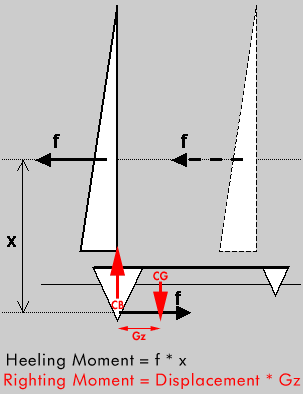Rig Placement and Heeling Load by Tom Speer
Subject: Re: [MHml] advantages and optimum uses for proas?
Date: Mon, 28 May 2001 10:25:18 -0700
From: "Tom Speer"
To: <multihulls@steamradio.com>
Rob Denney wrote:
>
>The force that immerses a cat or tri lee hull has 2 causes. First and foremost
>is the heeling load, caused by having the rig upwind of the lee hull.
I see no reason why it makes a difference to the heeling load whether the rig is located upwind or not. The lateral moment generated by the rig is the same.
It is convenient for analysis purposes to take the moments about a point below the mast so that the moment arm to the sail's center of effort is a constant and the force of the sail is acting at right angles to the moment arm. But you can use an arbitrary point - say, in either hull - and figure the moments about there. But the final results you get for the loads on each hull will be the same. For example, consider a catamaran with identical hulls and the mast in one of three places - windward hull, center, or leeward hull. Keep the center of gravity at the center for all three cases.
First take the catamaran case of the mast in the center and sum moments about a point below the mast and in line with the hulls' centers of buoyancy. Half of the heeling moment is reacted by an increase in buoyancy of the lee hull times half the beam and and half of the heeling moment is reacted by an equal decrease in buoyancy of the windward hull times half the beam. The total buoyancy remains the same and equal to the weight. So both the forces and moments balance.
Next take the case with the mast in the windward hull and take moments about a point below the mast at the level of the center of buoyancy of the windward hull. Now the moment arm of the windward hull is zero so it does not contribute to the heeling balance for this reference point. The heeling moment is reacted by the change in buoyancy of the leeward hull times the whole beam. This will turn out to be the same change in buoyancy as for the catamaran, because although the leeward hull is doing the job of both hulls in the catamaran, the lever arm of the lee hull is doubled (whole beam vs half beam) so it can react twice the moment (all the moment vs half the moment) with the same force.
But now the force balance is not right, because if the boat pivots about the windward hull, now the total buoyancy of the windward hull is the buoyancy it originally had, plus the increase in buoyancy of the leeward hull. So the whole boat must rise so as to reduce the buoyancy on the windward hull by the same amount it is increased on the leeward hull and keep the total buoyancy the same. So we get back to the same case as for the catamaran - equal change in buoyancy in each hull.
Finally, consider the pacific proa case with the mast in the lee hull. The same arguments apply. The heeling moment is reacted by a decrease in buoyancy in the windward hull. But the decrease in buoyancy has to be countered by an increase in buoyancy of the lee hull so as to keep the total buoyancy equal to the weight. So the windward and leeward hulls experience equal and opposite changes in their buoyancy. Just like the catamaran case.
Where you'll get a difference based on rig location is when the rig produces a substantial vertical load in addition to its horizontal loads, like an inclined rig. Then moving the rig will affect the heeling moment because you're changing the moment arm of the vertical component. So in this case, the Atlantic proa has an edge because the vertical loads due to the heel angle of the boat are farthest from the lee hull. But as long as we're talking about horizontal loads on the rig, you can move it anywhere in a horizontal plane without affecting the moments - it's only the difference between the plane of the rig center of effort and the plane of the lateral resistance that determines the heeling and pitching moment arm.
It's really the weight distribution and total beam that makes the difference between cat, proa, or tri. The tri makes it easier to have a greater total beam than the cat or proa for structural purposes. The proa makes it possible to move the center of gravity to windward compared to having it at the half-beam location of the tri and cat.
As I see it, the Pacific proa will have the same tendency to depress the leeward bow, given the same loads on the sail. But the total heeling moment will be limited by the location of the center of gravity of the boat. With a large hull to leeward and small hull to windward, the c.g. is closer to the leeward hull and so the boat can't be allowed to generate as much heeling moment before it starts flying the windward hull.
Take a look at the rig heights compared to the boat lengths of typical proa and cat/tri designs. A typical tri will have a mast that is half again as long as the boat. I don't think you see many proa masts that are this long. If there's a difference in bow burying, I think this is where you'll find it.
Tom Speer
me@tspeer.com
http://www.tspeer.com
_______________________________________________
Multihulls mailing list
Multihulls@steamradio.com
http://www.steamradio.com/mailman/listinfo/multihulls
Center of Buoyancy and Center of Gravity Ask A Scientist
Other Proa Pages
